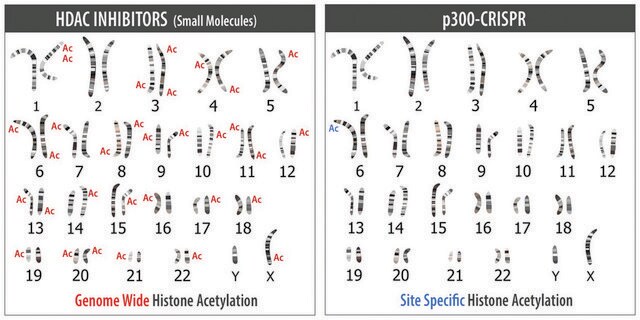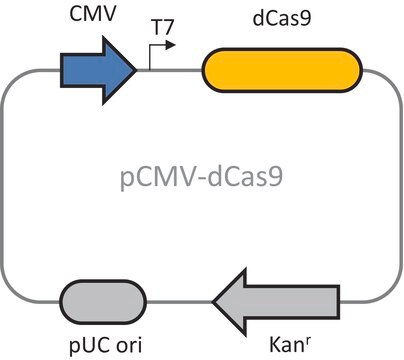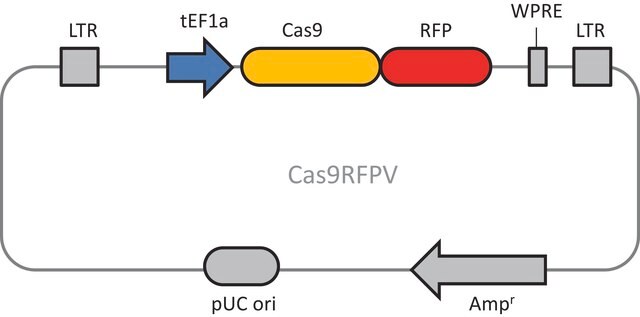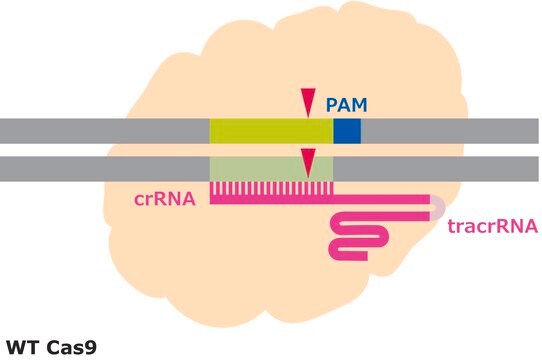DCAS9P300RFP
CRISPR dCas9-p300 RFP Activator Expression Plasmid
Anmeldenzur Ansicht organisationsspezifischer und vertraglich vereinbarter Preise
Alle Fotos(1)
About This Item
UNSPSC-Code:
12352200
NACRES:
NE.02
Empfohlene Produkte
Rekombinant
expressed in E. coli
Qualitätsniveau
Form
liquid
Verpackung
vial of 50 μL
Konzentration
20 ng/μL in TE buffer; DNA (1μg of plasmid DNA)
Anwendung(en)
CRISPR
Versandbedingung
dry ice
Lagertemp.
−20°C
Allgemeine Beschreibung
This gene activation system is based on a fusion of inactive Cas9 (dCas9) to the catalytic histone acetyltransferase (HAT) core domain of the human E1A-associated protein p300. The dCas9-p300 activator expression plasmids use the CMV promoter for strong transient expression of dCas9-P300 and RFP linked by a 2A peptide (CMV-dCas9-p300-2A-RFP) allowing for easy visualization of successful transfection. The dCas9-P300-RFP expression plasmid is one part of a two part CRISPR system with individual dCas9-P300 and gRNA expression vectors.
To order gRNA in any format click here
To order gRNA in any format click here
Anwendung
Functional Genomics/Target Validation
- Epigenetic Modification
- Transcriptional Activation
- Manufacture of dCas9-P300 expressing lentiviral particles
Leistungsmerkmale und Vorteile
The Sigma CRISPR dCas9p300 plasmid co-expresses p300-HAT and RFP, to easily monitor delivery and expression in your target cell type. gRNAs can successfully direct nuclease-deficient Cas9 (dCas9) fused to p300 HAT catalytic domain to increase levels of histone acetylation and endogenous gene expression. The dCas9-p300 histone acetylation approach represents a distinct mechanism of action relative to dCas9-VP64 or other similar gene activation motifs.
Prinzip
CRISPR/Cas systems are employed by bacteria and archaea as a defense against invading viruses and plasmids. Recently, the type II CRISPR/Cas system from the bacterium Streptococcus pyogenes has been engineered to function in eukaryotic systems using two molecular components: a single Cas9 protein and a non-coding guide RNA (gRNA). Mutations to the catalystic domains, RuvC and HnH, render it inactive as a nuclease yet still allow for the protein to be programmed with a single gRNA, directing p300 epigenetic modification cargo to any desired genomic location.
Rechtliche Hinweise
Lagerklassenschlüssel
10 - Combustible liquids
WGK
WGK 2
Flammpunkt (°F)
Not applicable
Flammpunkt (°C)
Not applicable
Hier finden Sie alle aktuellen Versionen:
Analysenzertifikate (COA)
Lot/Batch Number
Die passende Version wird nicht angezeigt?
Wenn Sie eine bestimmte Version benötigen, können Sie anhand der Lot- oder Chargennummer nach einem spezifischen Zertifikat suchen.
Besitzen Sie dieses Produkt bereits?
In der Dokumentenbibliothek finden Sie die Dokumentation zu den Produkten, die Sie kürzlich erworben haben.
Unser Team von Wissenschaftlern verfügt über Erfahrung in allen Forschungsbereichen einschließlich Life Science, Materialwissenschaften, chemischer Synthese, Chromatographie, Analytik und vielen mehr..
Setzen Sie sich mit dem technischen Dienst in Verbindung.








